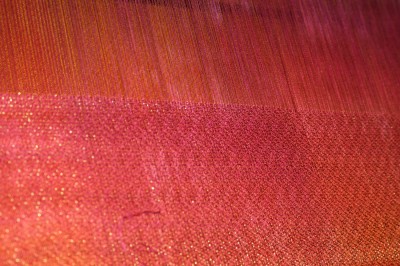I’m now contemplating potential wefts. My calculations tell me that if I want 6-8 yards for each garment, I’ll need 300-400 grams of weft for each. Running a search through my yarn database (at http://creator.zoho.com) revealed that I have four weft options: cotton, silk, merino wool, and linen. (The warp will be 60/2 silk.) So I’m considering what to use.
Linen is out. I know some people mix linen and silk, but I’m really not sure why: they are pretty much opposite in character, and have opposite care requirements. Linen is crisp and requires a hot iron; silk is drapey (unless the sericin is left in), and needs to be pressed at low temperatures. So I don’t think I’ll mix the two.
That leaves cotton, silk, and wool. Silk, of course, is wonderful stuff, and I have piles of it. So why would I consider cotton or wool? Well, cotton would allow me to cross-dye the finished piece, since silk takes acid dyes and cotton does not. This could come in handy, since it will allow me to dye the warp while leaving the weft (relatively) unchanged. Since I will be using the same (white) warp for all four pieces, this would give me more color variation. Cotton is also relatively easy to care for – you can toss it into the washer (on delicate) without worrying about felting.
Wool, of course, does felt, but it has a few advantages, too. Because wool felts, darts can be shrunk out easily. I’ve wanted to try the couture technique of shrinking out darts for awhile; wool would make that much easier, which is good for a novice. (Silk can be shrunk as well, but not as much and not as easily as wool.) It can also be cross-dyed when combined with silk, giving more color variation. It’s not as lustrous as silk, so if wool is used as a background, the silk will look shinier by comparison.
I think I will very likely use all three: wool for the jacket (and maybe the jacket-blouse); silk for one tunic, silk/cotton for the other. But, obviously, I will have to sample!
I also need to work out yardage requirements. My best guess is that it will take 8 yards for the jacket (and maybe the jacket/blouse), and 5-6 yards for each tunic. (Remember that my fabric is only 24″ wide!) That, assuming 15% shrinkage (take-up is about 7.5%, shrinkage about the same), plus one yard of loom waste, means I will have to put on my longest warp yet – 34 yards! I will probably allow another 3 yards for sampling (my warping wheel, without modifications, has a three-yard circumference), so that might be 37 yards. That’s a mighty long warp (for me anyway), but with only one shuttle to contend with, it ought to weave off relatively quickly. And I can cut off between pieces, and sew one while weaving another.
Off to work! I have an early morning meeting, but that just means I can come home (and start weaving!) sooner.
Finally, here is the pretty picture for today:

I’m pleased to say that my colors are matching, and the woven web is just beautiful. Can’t wait to see it wet-finished!
Off to work!

I always press my silk fabric (though not my store-bought things!) with high heat and lots of steam. So I don’t see a reason there for not combining it with linen.
good story about “mixed fibres” which one encounters all the time in textile conservation. Tapestries are typically wool and silk. The late Joe Columbus, conservator at one of the Washington collections, was faced with tarnished silver in some parts of an antique tapestry he was cleaning and knowing that anything he used to clean off the tarnish would damage the wool. He put the tapestry into the wash-tank, where the grid beneath it was aluminum, filled the tank with saline solution, then passed an electric current through the water, causing the tarnish to come off the silver and adhere to the aluminum. It was a great paper offered at one of the Como conferences. I always thought it was one of the neatest bits of “EUREKA!” moments I’ve ever run across!!!!